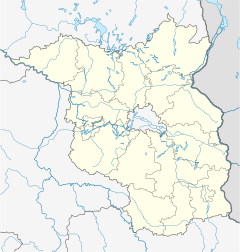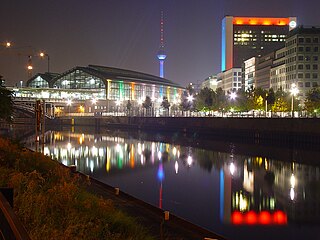
The Berlin S-Bahn is a rapid transit railway system in and around Berlin, the capital city of Germany. It has been in operation under this name since December 1930, having been previously called the special tariff area Berliner Stadt-, Ring- und Vorortbahnen. It complements the Berlin U-Bahn and is the link to many outer-Berlin areas, such as Berlin Brandenburg Airport. As such, the Berlin S-Bahn blends elements of a commuter rail service and a rapid transit system.
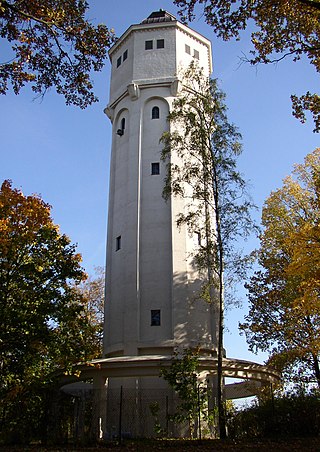
Hohen Neuendorf is a town in the Oberhavel district, in Brandenburg, Germany. It is located north west of Berlin.

Berlin-Wannsee station is a railway station opened in 1874 which lies in the Wannsee district of Berlin, the capital city of Germany. It is an important traffic junction in south-west Berlin that is served by the RegionalExpress and RegionalBahn trains of the Deutsche Bahn, the Harz-Berlin-Express of Veolia Verkehr and by the Berlin S-Bahn. In summer, Wannsee serves as the Berlin terminal for DB AutoZug car carrying trains to and from southern Europe.

Oranienburg is a railway station located in Oranienburg, Germany. The station was opened in 1877 is located on the Berlin Northern Railway and the now closed Nauen–Oranienburg railway and Oranienburg–Velten railway. The train services are operated by Deutsche Bahn and Niederbarnimer Eisenbahn.

Lehnitz is a railway station in the district of Lehnitz, Oranienburg, Germany. It is served by route S1 of the Berlin S-Bahn, with trains in both directions stopping every 20 min during the hours of operation.

Hohen Neuendorf is a railway station in the town of Hohen Neuendorf, Germany. It is served by the Berlin S-Bahn and by several local buses.

Berlin-Hermsdorf is a railway station in the neighbourhood of Hermsdorf, in the city of Berlin, Germany. It is served by the Berlin S-Bahn and by several local buses.

Berlin-Waidmannslust is a railway station in the neighbourhood of Waidmannslust, in the city of Berlin, Germany. It is served by the Berlin S-Bahn and by several local buses.

Berlin Bornholmer Straße is a railway station in the Prenzlauer Berg district of Berlin, Germany. It is served by the Berlin S-Bahn and the M13 and 50 lines of the Berlin Straßenbahn.
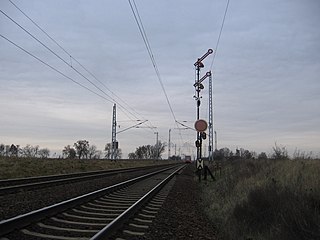
The Berlin Northern Railway is a 223-kilometre-long main line route, that runs from Berlin via Neustrelitz and Neubrandenburg to Stralsund on the Baltic Sea coast. Nowadays, long-distance and regional traffic on the Nordbahn is routed at Hohen Neuendorf onto the Berlin Outer Ring to the Karower Kreuz and on to Berlin Main Station or Berlin-Lichtenberg.

Hennigsdorf is a railway station in the Oberhavel district of Brandenburg, located in the town of Hennigsdorf. It is the northern terminus of the S-Bahn line S25 as well as a station for regional passenger trains and freight services.
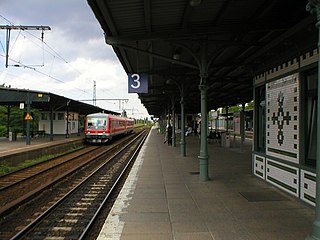
Berlin-Schöneweide is a railway station in Niederschöneweide, part of the Treptow-Köpenick borough of Berlin. It is served by the S-Bahn and regional trains, buses and trams. It was a terminal for long-distance trains until 2011.

Potsdam-Griebnitzsee station is a regional and S-Bahn station in Potsdam on the outskirts of Berlin in the German state of Brandenburg. The station is located in the east of the Babelsberg suburb of the city of Potsdam in the state of Brandenburg, and about 600 metres (2,000 ft) outside the Berlin city boundary. It takes its name from the adjacent Griebnitzsee lake. It is on the Wannsee Railway. During the division of Germany, it served as a border station for traffic to West Berlin. The station is now served by trains on line S7 of the Berlin S-Bahn and Regionalbahn services RB 20, RB 22, and RB 23. It is classified by Deutsche Bahn as a category 4 station.

Potsdam-Babelsberg station is an S-Bahn station in the Potsdam district of Babelsberg. It is located on the tracks of an extension of the Wannsee Railway between Griebnitzsee station and Potsdam Hauptbahnhof. It is classified by Deutsche Bahn as a category 5 station.

Potsdam Hauptbahnhof is the main station in the German city of Potsdam, capital of the state of Brandenburg. It lies on the Berlin–Magdeburg railway and was founded in 1838. However, it has had this name only since 1999. It was originally called Bahnhof Potsdam and it was called Potsdam Stadt (city) station from 1960. The station is the terminus of line S7 of the Berlin S-Bahn, which comes from Ahrensfelde. It is also connected with the central bus station, which is a transfer point between Potsdam and the southwestern region of Berlin, and has a stop on the Potsdam tram network. It is classified by Deutsche Bahn as a category 2 station.

The first section of the Berlin–Magdeburg Railway was opened in 1838 as the Berlin-Potsdam Railway also known as trunk line and was the first railway line in Prussia. In 1846 it was extended to Magdeburg.

The Wannsee Railway is a suburban railway in Berlin running from Potsdamer Platz via the Ring line station of Schöneberg to Wannsee station on Großer Wannsee, a lake after which it is named. Today it is a section of the Berlin S-Bahn line S1.

The Berlin outer ring is a 125 km (78 mi) long double track electrified railway, originally built by the German Democratic Republic to bypass West Berlin in preparation for the building of the Berlin Wall during the division of Germany. It was developed by East Germany for economic, transport policy, and military reasons between 1951 and 1961 and included parts of some older lines.
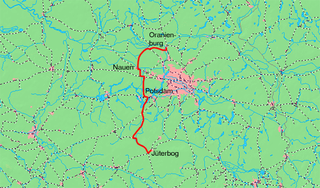
The Jüterbog–Nauen railway is a line that runs to the west of Berlin through the German state of Brandenburg. It runs from Jüterbog via Treuenbrietzen, Beelitz, Potsdam, Wustermark to Nauen. The line is a part of the Bypass Railway (Umgehungsbahn), which was primarily designed to relieve congestion on the railways in Berlin. The Wustermark–Nauen section has been closed, the Golm–Priort section is now a part of the Berlin outer ring and has been rebuilt as a double-track main line.

The Berlin S-Bahn began on 8 August 1924 with the first section from Stettiner Vorortbahnhof to Bernau using steam locomotives. On 13 August 1961 it was broken up when the Berlin Wall was built, resulting in two sections: the eastern part and the western part. The western part experienced a massive strike which resulted in closure of several stations, after declining use. Attempts were made to reopen at various times but in the end, only three lines were finally opened after the strike. Since 9 November 1989, when the Berlin Wall was opened, the Berlin S-Bahn began to expand rapidly with their budgetary costs.


